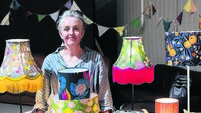Why fake grass is dead common as Hyacinth Bucket might say

"Fake lawn at side of house. Yes, this is the easiest lawn I've ever had to NOT maintain."
But I’m not likely to win any awards for gardening. The apple tree does its thing without any intervention. And I’ve had to hire a gardener to tame what increasingly was looking like a severely neglected wilderness.
You probably heard of ‘No Mow May’ to encourage wildlife in our gardens. I almost extended it through the summer to No Mow June/July/August, with the occasional foray out the back with my push lawnmower.
Now, as I look out the window, the rain is falling at an enthusiastic rate and yet more apples have landed on the grass, which means going out, when it dries, and gathering up the fruit to add to my stash, which is distributed to friends, family and neighbours.
I really should have a side hustle, selling apples. There are only so many apple crumbles that I can make every week. And the freezer is filling up with stewed apple.
Someone suggested I make apple chutney or apple jam and give it to people as Christmas gifts. It’s a fine and indeed worthy idea and would beat traipsing around shops looking for inspiration. But a bit labour-intensive.
Still, I just might go there. I’m definitely more at home working in the kitchen than toiling in the garden. I guess I’m destined to be an accidental gardener.
And while I’m all for having a low maintenance garden (my instruction to the gardener who is transforming my green space), I wouldn’t go down the route of carpeting the garden with fake grass. It’s surely déclassé? Or dead common, as Hyacinth Bucket might declare.
It’s almost on a par with plastic flowers. Do people still plonk fake roses in vases? It’s a terrible look.
Plastic grass, the lazy gardener’s solution to managing the lawn, has seen an upsurge in popularity in recent times as it’s seen as easier to look after than fresh lawn. But it’s controversial, almost non-PC in a world where even weed-killer is reacted to with hostility by serious gardeners.
In May, the Royal Horticultural Society in the UK announced a ban on artificial grass at its events this year, including the Chelsea Flower Show. The fatwa was introduced on the basis that fake grass damages the environment in more ways than one. Fossil fuels are used in its manufacture. And once plastic grass is laid down, it creates a sterile area in the garden.
The sterility means that this ‘grass’ blocks access to the soil beneath for burrowing insects and the ground above for soil-dwellers. But the market for plastic grass is growing around the world (the First World, I imagine) and is expected to rise to $5.8 billion by next year.
It suits city residents with shaded gardens where grass growth is poor. It appeals to people with urban rooftops and terraces, as well as families with children or dogs who don’t want mud coming into the house. And it’s a salve for people like me who struggle to tend to their garden.
The desire may be there to keep a perfectly coiffed green lawn all year round, but the reality is a patchy, weed-filled area that gives you the blues. I know all about it.
And it’s not just wildlife that plastic grass affects. Its manufacture leads to micro-plastics, the tiny particles of plastic that have made their way around the world and are present in our food and water – as well as being in the air we breathe.
And there are growing concerns about the impact of the synthetic chemicals that are added to fake grass, on our health and the environment. Carcinogens are suspected of being present in fake grass. It’s all very worrying.
On the plus side, fake grass doesn’t require fertilisers, some of which can be very harmful to the environment.
But don’t fake it in the garden. Think of the bees...







 App?
App?







